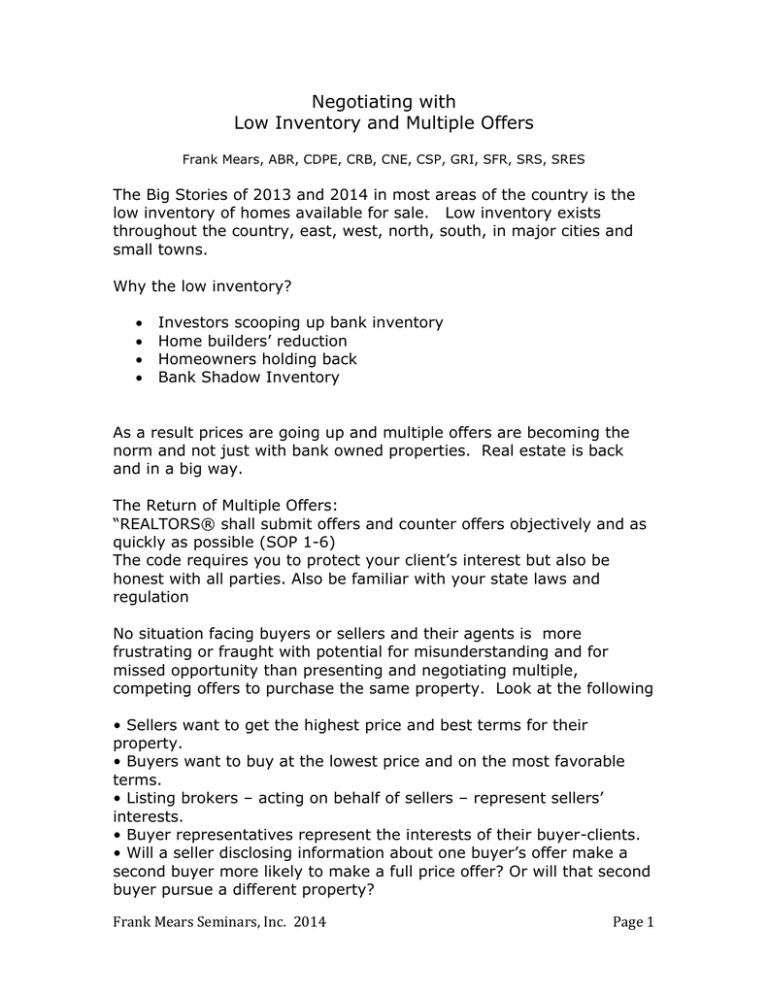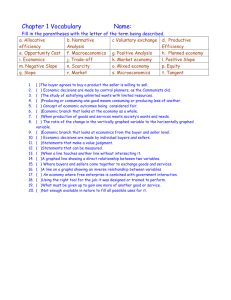Negotiating with Low Inventory and Multiple Offers Frank Mears
advertisement

Negotiating with Low Inventory and Multiple Offers Frank Mears, ABR, CDPE, CRB, CNE, CSP, GRI, SFR, SRS, SRES The Big Stories of 2013 and 2014 in most areas of the country is the low inventory of homes available for sale. Low inventory exists throughout the country, east, west, north, south, in major cities and small towns. Why the low inventory? Investors scooping up bank inventory Home builders’ reduction Homeowners holding back Bank Shadow Inventory As a result prices are going up and multiple offers are becoming the norm and not just with bank owned properties. Real estate is back and in a big way. The Return of Multiple Offers: “REALTORS® shall submit offers and counter offers objectively and as quickly as possible (SOP 1-6) The code requires you to protect your client’s interest but also be honest with all parties. Also be familiar with your state laws and regulation No situation facing buyers or sellers and their agents is more frustrating or fraught with potential for misunderstanding and for missed opportunity than presenting and negotiating multiple, competing offers to purchase the same property. Look at the following • Sellers want to get the highest price and best terms for their property. • Buyers want to buy at the lowest price and on the most favorable terms. • Listing brokers – acting on behalf of sellers – represent sellers’ interests. • Buyer representatives represent the interests of their buyer-clients. • Will a seller disclosing information about one buyer’s offer make a second buyer more likely to make a full price offer? Or will that second buyer pursue a different property? Frank Mears Seminars, Inc. 2014 Page 1 • Will telling several buyers that each is being given a chance to make their “best offer” result in spirited competition for the seller’s property? Or will it result in the buyers looking elsewhere? • What’s fair? What’s honest? Why isn’t there a single, simple way to deal with multiple competing offers? The Seller’s side of Multiple Offers. When listing property make the seller aware of the possibility of receiving multiple offers and go over the various ways they may be dealt with. For example, the seller can accept the best offer; or inform all buyers that other offers are on the table and invite them to make their best offer; the seller can counter one offer and put the others on hold until you get a response or you can counter one and reject all the others. Each approach has advantages and disadvantages. The Risks to the seller and sellers agent: 1. Some buyer (or buyers) is going to be unhappy and unhappy buyers are the one that file lawsuits and or complaints with the real estate regulatory agency in your state. 2. While multiple offers sometime result in a higher price to the seller there is a risk of all buyers walking away. Some buyers, especially those that have other options to choose from, will simply not play the game and walk away. “Highest and best” may result in a better offer or may discourage offers and result in no offers 3. There is also a risk of the seller mistakenly obligating themselves to more than one contract Remember and remind the seller that the decisions are theirs to makeNot Yours and you are bound by their lawful and ethical instructions. REALTORS® can only, with the seller’s approval, divulge the existence of offers on the property (SOP 1-15) The Buyer’s Side of Multiple Offers 1. Gather information on the seller (from listing agent, neighbors, etc.) 2. Encourage the buyer to make a strong offer (give the seller what’s most important to them. 3. Strike while the iron is hot. 4. Encourage the buyer to Not “Major in the Minors” Frank Mears Seminars, Inc. 2014 Page 2 The buyer’s agent should inform the buyer of the sellers options: They can accept the best offer; or inform all buyers that other offers are on the table and invite them to make their best offer; the seller can counter one offer and put the others on hold until you get a response or you can counter one and reject all the others. Each approach has advantages and disadvantages. While multiple offers sometime result in a higher price to the seller there is a risk of all buyers walking away. Some buyers, especially those that have other options to choose from, will simply not play the game and walk away. “Highest and best” may result in a better offer or may discourage offers and result in no offers. Standard of Practice 1-13 gives guidance for both buyer’s agents and listing agents about disclosure of the terms of the multiple offers. “When entering into buyer/tenant agreements, REALTORS® must advise potential clients of . . . the possibility that sellers or sellers’ representatives may not treat the existence, terms, or conditions of offers as confidential unless confidentiality is required by law, regulation, or by any confidentiality agreement between the parties.” Presenting Multiple offers to the seller using the Grid Method from the Sellers Representative Specialist course • All offers entered by feature • Simplifies comparison • Provided seller with un-biased analysis • Streamlines the counter offer process • Seller can counter individual terms • Seller focused on the real amount that they will yield as well as the comparative terms and conditions rather than gross amount Frank Mears Seminars, Inc. 2014 Page 3 The Appraisal issue with Multiple offers. Multiple offers may result in the property not appraising for the sale price. Seller can minimize this risk by putting a special stipulation in the contract that the “Buyer will pay any difference between the sales price and appraised value in cash at closing”. (Have a local attorney draft the language to conform to the laws in your state). Realize that in Multiple offer situations someone is going to be disappointed. Make sure everyone was treated honestly throughout the process with prompt and open communication. Multiple offers are a good sign of the changing times we find ourselves in. Frank Mears Seminars, Inc. 2014 Page 4







